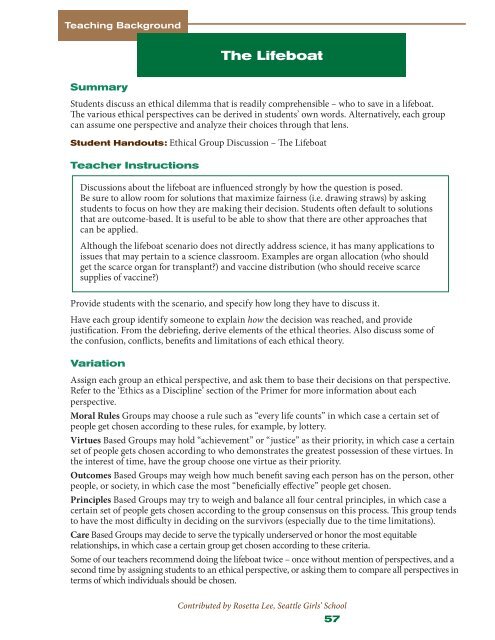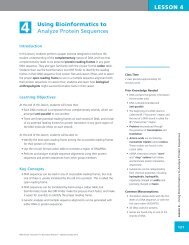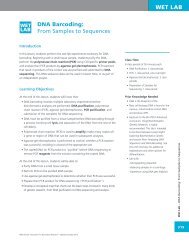57 Students discuss an ethical dilemma that is readily ...
57 Students discuss an ethical dilemma that is readily ...
57 Students discuss an ethical dilemma that is readily ...
You also want an ePaper? Increase the reach of your titles
YUMPU automatically turns print PDFs into web optimized ePapers that Google loves.
Teaching Background<strong>Students</strong> <strong>d<strong>is</strong>cuss</strong> <strong>an</strong> <strong>ethical</strong> <strong>dilemma</strong> <strong>that</strong> <strong>is</strong> <strong>readily</strong> comprehensible – who to save in a lifeboat.The various <strong>ethical</strong> perspectives c<strong>an</strong> be derived in students’ own words. Alternatively, each groupc<strong>an</strong> assume one perspective <strong>an</strong>d <strong>an</strong>alyze their choices through <strong>that</strong> lens.Student H<strong>an</strong>douts: Ethical Group D<strong>is</strong>cussion – The LifeboatD<strong>is</strong>cussions about the lifeboat are influenced strongly by how the question <strong>is</strong> posed.Be sure to allow room for solutions <strong>that</strong> maximize fairness (i.e. drawing straws) by askingstudents to focus on how they are making their dec<strong>is</strong>ion. <strong>Students</strong> often default to solutions<strong>that</strong> are outcome-based. It <strong>is</strong> useful to be able to show <strong>that</strong> there are other approaches <strong>that</strong>c<strong>an</strong> be applied.Although the lifeboat scenario does not directly address science, it has m<strong>an</strong>y applications to<strong>is</strong>sues <strong>that</strong> may pertain to a science classroom. Examples are org<strong>an</strong> allocation (who shouldget the scarce org<strong>an</strong> for tr<strong>an</strong>spl<strong>an</strong>t?) <strong>an</strong>d vaccine d<strong>is</strong>tribution (who should receive scarcesupplies of vaccine?)Provide students with the scenario, <strong>an</strong>d specify how long they have to <strong>d<strong>is</strong>cuss</strong> it.Have each group identify someone to explain how the dec<strong>is</strong>ion was reached, <strong>an</strong>d providejustification. From the debriefing, derive elements of the <strong>ethical</strong> theories. Also <strong>d<strong>is</strong>cuss</strong> some ofthe confusion, conflicts, benefits <strong>an</strong>d limitations of each <strong>ethical</strong> theory.Assign each group <strong>an</strong> <strong>ethical</strong> perspective, <strong>an</strong>d ask them to base their dec<strong>is</strong>ions on <strong>that</strong> perspective.Refer to the ‘Ethics as a D<strong>is</strong>cipline’ section of the Primer for more information about eachperspective.Moral Rules Groups may choose a rule such as “every life counts” in which case a certain set ofpeople get chosen according to these rules, for example, by lottery.Virtues Based Groups may hold “achievement” or “justice” as their priority, in which case a certainset of people gets chosen according to who demonstrates the greatest possession of these virtues. Inthe interest of time, have the group choose one virtue as their priority.Outcomes Based Groups may weigh how much benefit saving each person has on the person, otherpeople, or society, in which case the most “beneficially effective” people get chosen.Principles Based Groups may try to weigh <strong>an</strong>d bal<strong>an</strong>ce all four central principles, in which case acertain set of people gets chosen according to the group consensus on th<strong>is</strong> process. Th<strong>is</strong> group tendsto have the most difficulty in deciding on the survivors (especially due to the time limitations).Care Based Groups may decide to serve the typically underserved or honor the most equitablerelationships, in which case a certain group get chosen according to these criteria.Some of our teachers recommend doing the lifeboat twice – once without mention of perspectives, <strong>an</strong>d asecond time by assigning students to <strong>an</strong> <strong>ethical</strong> perspective, or asking them to compare all perspectives interms of which individuals should be chosen.Contributed by Rosetta Lee, Seattle Girls’ School<strong>57</strong>
Teaching BackgroundClassic Ethical DilemmasSummary<strong>Students</strong> use simple classic <strong>dilemma</strong>s to learn about or reinforce theirunderst<strong>an</strong>ding of <strong>ethical</strong> theories <strong>an</strong>d perspectivesStudent H<strong>an</strong>dout: Classic Ethical DilemmasTeacher InstructionsBefore learning about <strong>ethical</strong> perspectives:Have small groups of students brainstorm their solutions to thevarious problems. Use the <strong>d<strong>is</strong>cuss</strong>ion as a way to teach the <strong>ethical</strong>perspectives by introducing them <strong>an</strong>d showing how each <strong>dilemma</strong>would be addressed using <strong>that</strong> theoretical lens.After learning the <strong>ethical</strong> perspectives:If students have already been exposed to <strong>ethical</strong> perspectives <strong>an</strong>dtheories, these <strong>dilemma</strong>s are a way of reinforcing <strong>that</strong> learning.Ask students to develop <strong>an</strong>swers to the <strong>dilemma</strong>s from the variousperspectives.Note: These <strong>dilemma</strong>s c<strong>an</strong> also be used in conjunction with the‘Introduction to the Dec<strong>is</strong>ion-Making Model’ activity. Additionalsample cases are provided in the Appendix.59
Student H<strong>an</strong>doutNAME___________________________________________________________ Date_________ Period_______The ‘Heinz’ DilemmaClassic Ethical DilemmasMr. Heinz <strong>is</strong> ordinarily a law-abiding m<strong>an</strong>. One day, h<strong>is</strong> wife becomes gravely ill. Heinz takes her to thedoctor, who prescribes a medication for her. She does quite well on th<strong>is</strong> medication <strong>an</strong>d begins to recover.However, Heinz has no insur<strong>an</strong>ce <strong>an</strong>d runs out of money quickly paying for th<strong>is</strong> expensive medication.After a few months, he c<strong>an</strong> no longer purchase the medication <strong>an</strong>d h<strong>is</strong> wife begins to take a turn for theworse. One day, he <strong>is</strong> in the pharmacy <strong>an</strong>d notices <strong>that</strong> no one <strong>is</strong> behind the counter. The medication <strong>is</strong> inplain view. Should he steal the medication to help h<strong>is</strong> sick wife?The Old Wom<strong>an</strong> in the AirportYou are in the airport, trying to catch a flight <strong>that</strong> <strong>is</strong> about to leave. As you run down the crowdedcorridor, <strong>an</strong> elderly wom<strong>an</strong> suddenly slips in front of you <strong>an</strong>d falls to the ground with a cry. Do you stopto help, if you know you will m<strong>is</strong>s your flight because of it?The ‘Trolley’Trolley Scenario 1A trolley <strong>is</strong> running out of control down a track. In its path are 5 people who have been tied to the trackby a mad philosopher. Fortunately, you c<strong>an</strong> flip a switch which will lead the trolley down a differenttrack. Unfortunately, there <strong>is</strong> a single person tied to <strong>that</strong> track. Should you flip the switch? Why?Trolley Scenario 2As before, a trolley <strong>is</strong> hurtling down a track towards five people. You are on a bridge under which it willpass, <strong>an</strong>d you c<strong>an</strong> stop it by dropping a heavy weight in front of it. As it happens, there <strong>is</strong> a m<strong>an</strong> next toyou - your only way to stop the trolley <strong>is</strong> to push him over the bridge <strong>an</strong>d onto the track, killing him tosave five. Should you proceed? Why? How <strong>is</strong> th<strong>is</strong> case different from the first?The Old Wom<strong>an</strong> in the Airport <strong>is</strong> modified from Zimmer, C, Whose Life Would You Save? D<strong>is</strong>cover, April 2004The Trolley Problem originates from Philippa Foot, The Problem of Abortion <strong>an</strong>d the Doctrine of the Double Effect inVirtues <strong>an</strong>d Vices (Oxford: Basil Blackwell, 1978). It has been elaborated on by Judith Jarv<strong>is</strong> Thomson, Killing, LettingDie, <strong>an</strong>d the Trolley Problem, 59 The Mon<strong>is</strong>t 204-17 (1976) <strong>an</strong>d Judith Jarv<strong>is</strong> Thomson, The Trolley Problem, 94 YaleLaw Journal 1395-1415 (1985). Modified from Wikipedia, http://en.wikipedia.org/wiki/Trolley_Problem60
















